Analyzing Greenwashing's Impact on H&M's Brand Image: A Case Study
VerifiedAdded on 2021/01/03
|31
|9284
|321
Report
AI Summary
This report investigates the effects of greenwashing practices on the brand image of H&M, a prominent fast-fashion retailer. The introduction sets the context by discussing corporate strategy, sustainability, and the actions of H&M, particularly their 'World Recycle Week' campaign, which aimed to portray environmental friendliness. The report delves into the concepts of corporate governance and sustainability, emphasizing their importance for businesses. It defines greenwashing and analyzes its impact on H&M's brand image, exploring the company's strategies and their consequences. The research methodology involves secondary data collection and thematic analysis, focusing on corporate governance structure, sustainability, and greenwashing's impact. The report provides a critical review of the findings, offering recommendations and a conclusion summarizing the key insights, supported by references and a Gantt chart outlining the research timeline. The case study highlights how H&M's greenwashing practices, such as the collection of used clothes, have affected its brand reputation, particularly due to the company's environmental impact and the need to adhere to international guidelines.
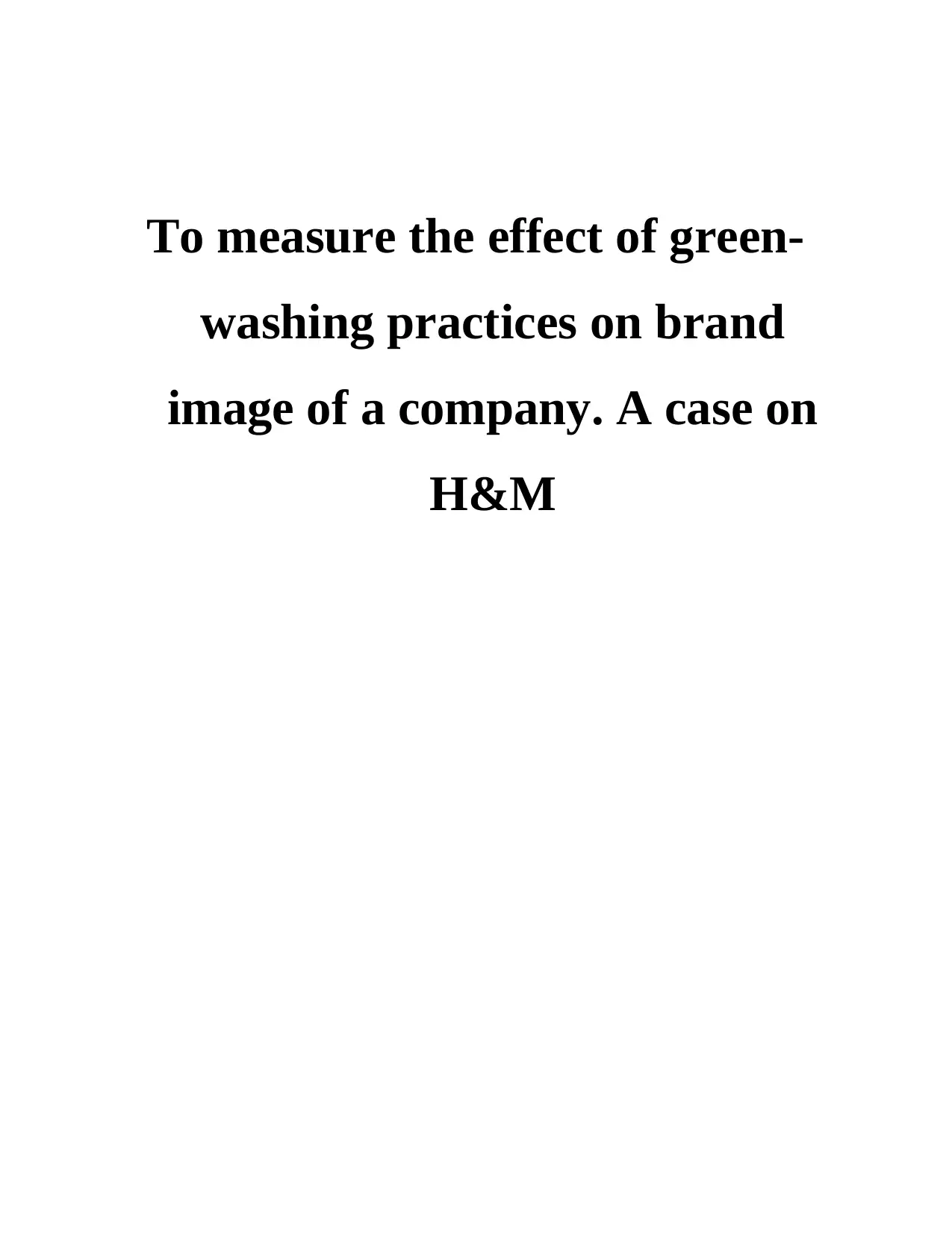
To measure the effect of green-
washing practices on brand
image of a company. A case on
H&M
washing practices on brand
image of a company. A case on
H&M
Paraphrase This Document
Need a fresh take? Get an instant paraphrase of this document with our AI Paraphraser
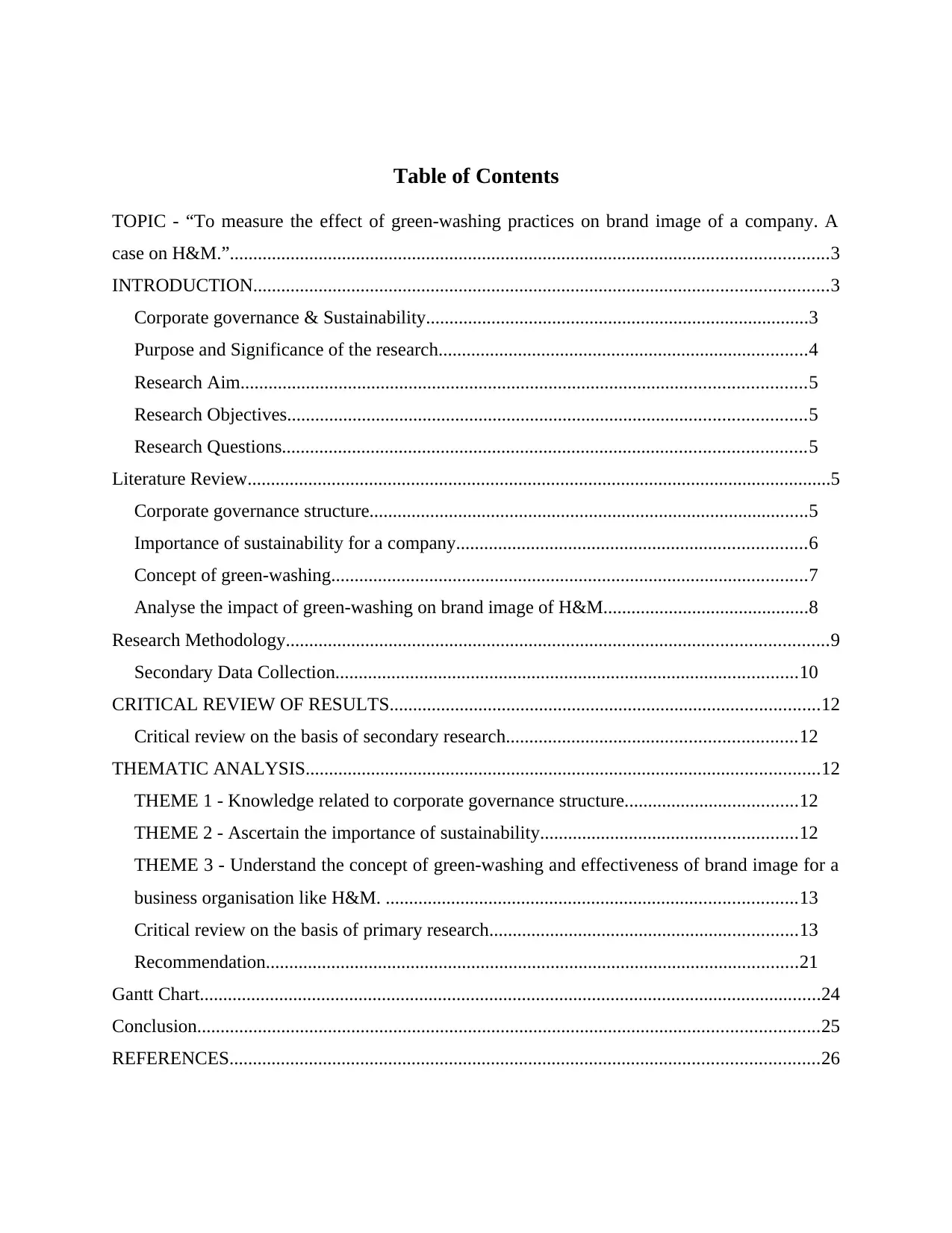
Table of Contents
TOPIC - “To measure the effect of green-washing practices on brand image of a company. A
case on H&M.”................................................................................................................................3
INTRODUCTION...........................................................................................................................3
Corporate governance & Sustainability..................................................................................3
Purpose and Significance of the research...............................................................................4
Research Aim.........................................................................................................................5
Research Objectives...............................................................................................................5
Research Questions................................................................................................................5
Literature Review.............................................................................................................................5
Corporate governance structure..............................................................................................5
Importance of sustainability for a company...........................................................................6
Concept of green-washing......................................................................................................7
Analyse the impact of green-washing on brand image of H&M............................................8
Research Methodology....................................................................................................................9
Secondary Data Collection...................................................................................................10
CRITICAL REVIEW OF RESULTS............................................................................................12
Critical review on the basis of secondary research..............................................................12
THEMATIC ANALYSIS..............................................................................................................12
THEME 1 - Knowledge related to corporate governance structure.....................................12
THEME 2 - Ascertain the importance of sustainability.......................................................12
THEME 3 - Understand the concept of green-washing and effectiveness of brand image for a
business organisation like H&M. ........................................................................................13
Critical review on the basis of primary research..................................................................13
Recommendation..................................................................................................................21
Gantt Chart.....................................................................................................................................24
Conclusion.....................................................................................................................................25
REFERENCES..............................................................................................................................26
TOPIC - “To measure the effect of green-washing practices on brand image of a company. A
case on H&M.”................................................................................................................................3
INTRODUCTION...........................................................................................................................3
Corporate governance & Sustainability..................................................................................3
Purpose and Significance of the research...............................................................................4
Research Aim.........................................................................................................................5
Research Objectives...............................................................................................................5
Research Questions................................................................................................................5
Literature Review.............................................................................................................................5
Corporate governance structure..............................................................................................5
Importance of sustainability for a company...........................................................................6
Concept of green-washing......................................................................................................7
Analyse the impact of green-washing on brand image of H&M............................................8
Research Methodology....................................................................................................................9
Secondary Data Collection...................................................................................................10
CRITICAL REVIEW OF RESULTS............................................................................................12
Critical review on the basis of secondary research..............................................................12
THEMATIC ANALYSIS..............................................................................................................12
THEME 1 - Knowledge related to corporate governance structure.....................................12
THEME 2 - Ascertain the importance of sustainability.......................................................12
THEME 3 - Understand the concept of green-washing and effectiveness of brand image for a
business organisation like H&M. ........................................................................................13
Critical review on the basis of primary research..................................................................13
Recommendation..................................................................................................................21
Gantt Chart.....................................................................................................................................24
Conclusion.....................................................................................................................................25
REFERENCES..............................................................................................................................26
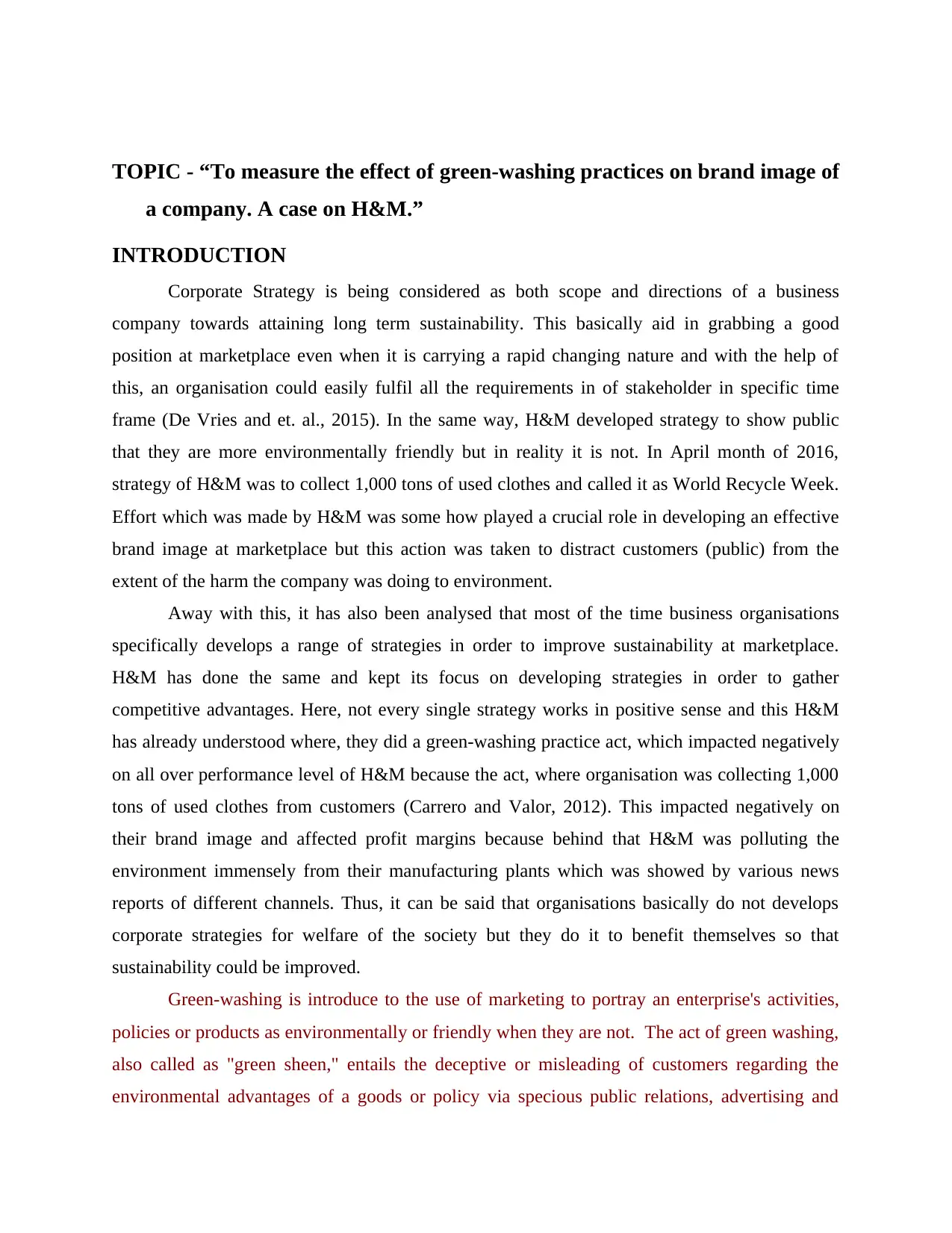
TOPIC - “To measure the effect of green-washing practices on brand image of
a company. A case on H&M.”
INTRODUCTION
Corporate Strategy is being considered as both scope and directions of a business
company towards attaining long term sustainability. This basically aid in grabbing a good
position at marketplace even when it is carrying a rapid changing nature and with the help of
this, an organisation could easily fulfil all the requirements in of stakeholder in specific time
frame (De Vries and et. al., 2015). In the same way, H&M developed strategy to show public
that they are more environmentally friendly but in reality it is not. In April month of 2016,
strategy of H&M was to collect 1,000 tons of used clothes and called it as World Recycle Week.
Effort which was made by H&M was some how played a crucial role in developing an effective
brand image at marketplace but this action was taken to distract customers (public) from the
extent of the harm the company was doing to environment.
Away with this, it has also been analysed that most of the time business organisations
specifically develops a range of strategies in order to improve sustainability at marketplace.
H&M has done the same and kept its focus on developing strategies in order to gather
competitive advantages. Here, not every single strategy works in positive sense and this H&M
has already understood where, they did a green-washing practice act, which impacted negatively
on all over performance level of H&M because the act, where organisation was collecting 1,000
tons of used clothes from customers (Carrero and Valor, 2012). This impacted negatively on
their brand image and affected profit margins because behind that H&M was polluting the
environment immensely from their manufacturing plants which was showed by various news
reports of different channels. Thus, it can be said that organisations basically do not develops
corporate strategies for welfare of the society but they do it to benefit themselves so that
sustainability could be improved.
Green-washing is introduce to the use of marketing to portray an enterprise's activities,
policies or products as environmentally or friendly when they are not. The act of green washing,
also called as "green sheen," entails the deceptive or misleading of customers regarding the
environmental advantages of a goods or policy via specious public relations, advertising and
a company. A case on H&M.”
INTRODUCTION
Corporate Strategy is being considered as both scope and directions of a business
company towards attaining long term sustainability. This basically aid in grabbing a good
position at marketplace even when it is carrying a rapid changing nature and with the help of
this, an organisation could easily fulfil all the requirements in of stakeholder in specific time
frame (De Vries and et. al., 2015). In the same way, H&M developed strategy to show public
that they are more environmentally friendly but in reality it is not. In April month of 2016,
strategy of H&M was to collect 1,000 tons of used clothes and called it as World Recycle Week.
Effort which was made by H&M was some how played a crucial role in developing an effective
brand image at marketplace but this action was taken to distract customers (public) from the
extent of the harm the company was doing to environment.
Away with this, it has also been analysed that most of the time business organisations
specifically develops a range of strategies in order to improve sustainability at marketplace.
H&M has done the same and kept its focus on developing strategies in order to gather
competitive advantages. Here, not every single strategy works in positive sense and this H&M
has already understood where, they did a green-washing practice act, which impacted negatively
on all over performance level of H&M because the act, where organisation was collecting 1,000
tons of used clothes from customers (Carrero and Valor, 2012). This impacted negatively on
their brand image and affected profit margins because behind that H&M was polluting the
environment immensely from their manufacturing plants which was showed by various news
reports of different channels. Thus, it can be said that organisations basically do not develops
corporate strategies for welfare of the society but they do it to benefit themselves so that
sustainability could be improved.
Green-washing is introduce to the use of marketing to portray an enterprise's activities,
policies or products as environmentally or friendly when they are not. The act of green washing,
also called as "green sheen," entails the deceptive or misleading of customers regarding the
environmental advantages of a goods or policy via specious public relations, advertising and
⊘ This is a preview!⊘
Do you want full access?
Subscribe today to unlock all pages.

Trusted by 1+ million students worldwide
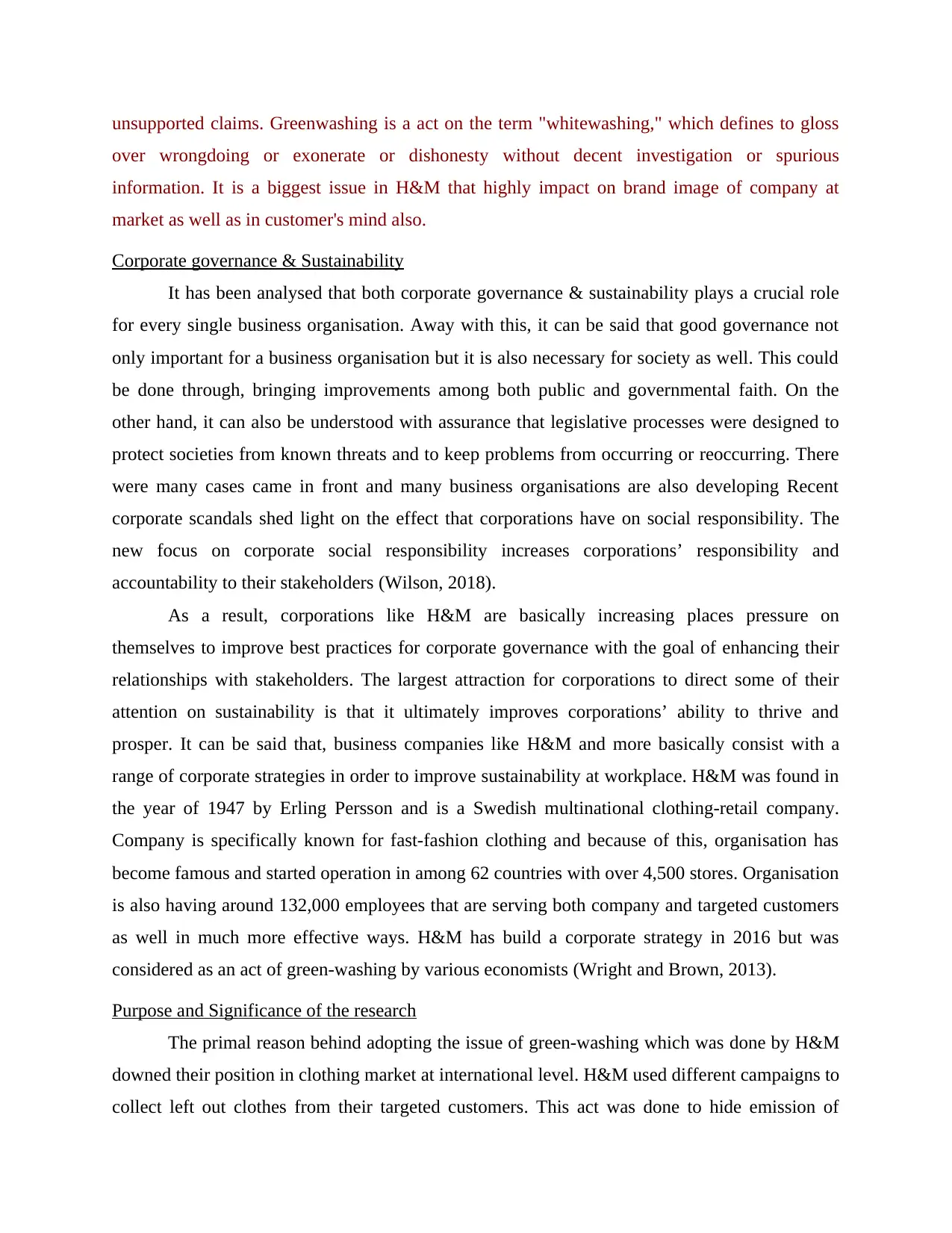
unsupported claims. Greenwashing is a act on the term "whitewashing," which defines to gloss
over wrongdoing or exonerate or dishonesty without decent investigation or spurious
information. It is a biggest issue in H&M that highly impact on brand image of company at
market as well as in customer's mind also.
Corporate governance & Sustainability
It has been analysed that both corporate governance & sustainability plays a crucial role
for every single business organisation. Away with this, it can be said that good governance not
only important for a business organisation but it is also necessary for society as well. This could
be done through, bringing improvements among both public and governmental faith. On the
other hand, it can also be understood with assurance that legislative processes were designed to
protect societies from known threats and to keep problems from occurring or reoccurring. There
were many cases came in front and many business organisations are also developing Recent
corporate scandals shed light on the effect that corporations have on social responsibility. The
new focus on corporate social responsibility increases corporations’ responsibility and
accountability to their stakeholders (Wilson, 2018).
As a result, corporations like H&M are basically increasing places pressure on
themselves to improve best practices for corporate governance with the goal of enhancing their
relationships with stakeholders. The largest attraction for corporations to direct some of their
attention on sustainability is that it ultimately improves corporations’ ability to thrive and
prosper. It can be said that, business companies like H&M and more basically consist with a
range of corporate strategies in order to improve sustainability at workplace. H&M was found in
the year of 1947 by Erling Persson and is a Swedish multinational clothing-retail company.
Company is specifically known for fast-fashion clothing and because of this, organisation has
become famous and started operation in among 62 countries with over 4,500 stores. Organisation
is also having around 132,000 employees that are serving both company and targeted customers
as well in much more effective ways. H&M has build a corporate strategy in 2016 but was
considered as an act of green-washing by various economists (Wright and Brown, 2013).
Purpose and Significance of the research
The primal reason behind adopting the issue of green-washing which was done by H&M
downed their position in clothing market at international level. H&M used different campaigns to
collect left out clothes from their targeted customers. This act was done to hide emission of
over wrongdoing or exonerate or dishonesty without decent investigation or spurious
information. It is a biggest issue in H&M that highly impact on brand image of company at
market as well as in customer's mind also.
Corporate governance & Sustainability
It has been analysed that both corporate governance & sustainability plays a crucial role
for every single business organisation. Away with this, it can be said that good governance not
only important for a business organisation but it is also necessary for society as well. This could
be done through, bringing improvements among both public and governmental faith. On the
other hand, it can also be understood with assurance that legislative processes were designed to
protect societies from known threats and to keep problems from occurring or reoccurring. There
were many cases came in front and many business organisations are also developing Recent
corporate scandals shed light on the effect that corporations have on social responsibility. The
new focus on corporate social responsibility increases corporations’ responsibility and
accountability to their stakeholders (Wilson, 2018).
As a result, corporations like H&M are basically increasing places pressure on
themselves to improve best practices for corporate governance with the goal of enhancing their
relationships with stakeholders. The largest attraction for corporations to direct some of their
attention on sustainability is that it ultimately improves corporations’ ability to thrive and
prosper. It can be said that, business companies like H&M and more basically consist with a
range of corporate strategies in order to improve sustainability at workplace. H&M was found in
the year of 1947 by Erling Persson and is a Swedish multinational clothing-retail company.
Company is specifically known for fast-fashion clothing and because of this, organisation has
become famous and started operation in among 62 countries with over 4,500 stores. Organisation
is also having around 132,000 employees that are serving both company and targeted customers
as well in much more effective ways. H&M has build a corporate strategy in 2016 but was
considered as an act of green-washing by various economists (Wright and Brown, 2013).
Purpose and Significance of the research
The primal reason behind adopting the issue of green-washing which was done by H&M
downed their position in clothing market at international level. H&M used different campaigns to
collect left out clothes from their targeted customers. This act was done to hide emission of
Paraphrase This Document
Need a fresh take? Get an instant paraphrase of this document with our AI Paraphraser
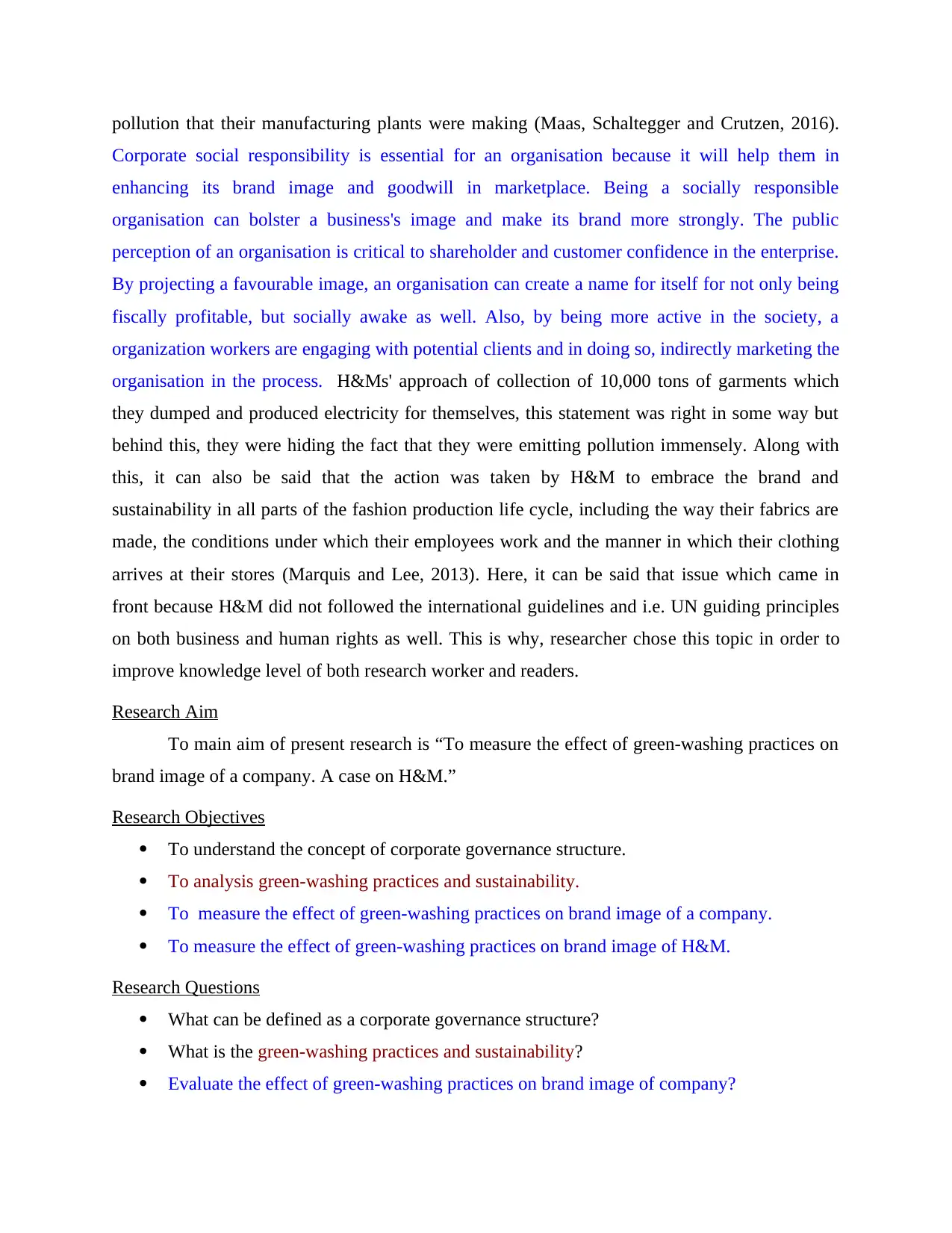
pollution that their manufacturing plants were making (Maas, Schaltegger and Crutzen, 2016).
Corporate social responsibility is essential for an organisation because it will help them in
enhancing its brand image and goodwill in marketplace. Being a socially responsible
organisation can bolster a business's image and make its brand more strongly. The public
perception of an organisation is critical to shareholder and customer confidence in the enterprise.
By projecting a favourable image, an organisation can create a name for itself for not only being
fiscally profitable, but socially awake as well. Also, by being more active in the society, a
organization workers are engaging with potential clients and in doing so, indirectly marketing the
organisation in the process. H&Ms' approach of collection of 10,000 tons of garments which
they dumped and produced electricity for themselves, this statement was right in some way but
behind this, they were hiding the fact that they were emitting pollution immensely. Along with
this, it can also be said that the action was taken by H&M to embrace the brand and
sustainability in all parts of the fashion production life cycle, including the way their fabrics are
made, the conditions under which their employees work and the manner in which their clothing
arrives at their stores (Marquis and Lee, 2013). Here, it can be said that issue which came in
front because H&M did not followed the international guidelines and i.e. UN guiding principles
on both business and human rights as well. This is why, researcher chose this topic in order to
improve knowledge level of both research worker and readers.
Research Aim
To main aim of present research is “To measure the effect of green-washing practices on
brand image of a company. A case on H&M.”
Research Objectives
To understand the concept of corporate governance structure.
To analysis green-washing practices and sustainability.
To measure the effect of green-washing practices on brand image of a company.
To measure the effect of green-washing practices on brand image of H&M.
Research Questions
What can be defined as a corporate governance structure?
What is the green-washing practices and sustainability?
Evaluate the effect of green-washing practices on brand image of company?
Corporate social responsibility is essential for an organisation because it will help them in
enhancing its brand image and goodwill in marketplace. Being a socially responsible
organisation can bolster a business's image and make its brand more strongly. The public
perception of an organisation is critical to shareholder and customer confidence in the enterprise.
By projecting a favourable image, an organisation can create a name for itself for not only being
fiscally profitable, but socially awake as well. Also, by being more active in the society, a
organization workers are engaging with potential clients and in doing so, indirectly marketing the
organisation in the process. H&Ms' approach of collection of 10,000 tons of garments which
they dumped and produced electricity for themselves, this statement was right in some way but
behind this, they were hiding the fact that they were emitting pollution immensely. Along with
this, it can also be said that the action was taken by H&M to embrace the brand and
sustainability in all parts of the fashion production life cycle, including the way their fabrics are
made, the conditions under which their employees work and the manner in which their clothing
arrives at their stores (Marquis and Lee, 2013). Here, it can be said that issue which came in
front because H&M did not followed the international guidelines and i.e. UN guiding principles
on both business and human rights as well. This is why, researcher chose this topic in order to
improve knowledge level of both research worker and readers.
Research Aim
To main aim of present research is “To measure the effect of green-washing practices on
brand image of a company. A case on H&M.”
Research Objectives
To understand the concept of corporate governance structure.
To analysis green-washing practices and sustainability.
To measure the effect of green-washing practices on brand image of a company.
To measure the effect of green-washing practices on brand image of H&M.
Research Questions
What can be defined as a corporate governance structure?
What is the green-washing practices and sustainability?
Evaluate the effect of green-washing practices on brand image of company?
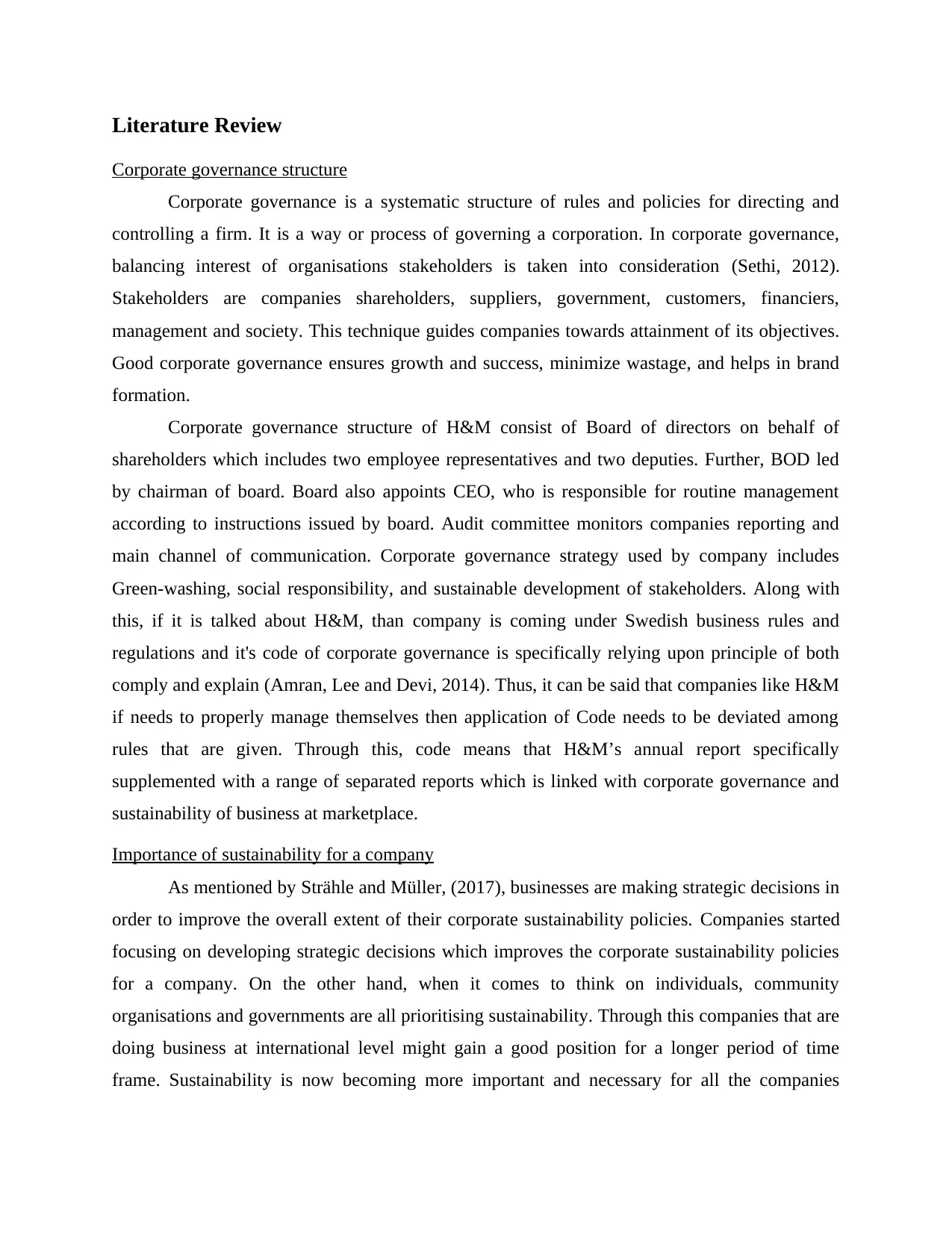
Literature Review
Corporate governance structure
Corporate governance is a systematic structure of rules and policies for directing and
controlling a firm. It is a way or process of governing a corporation. In corporate governance,
balancing interest of organisations stakeholders is taken into consideration (Sethi, 2012).
Stakeholders are companies shareholders, suppliers, government, customers, financiers,
management and society. This technique guides companies towards attainment of its objectives.
Good corporate governance ensures growth and success, minimize wastage, and helps in brand
formation.
Corporate governance structure of H&M consist of Board of directors on behalf of
shareholders which includes two employee representatives and two deputies. Further, BOD led
by chairman of board. Board also appoints CEO, who is responsible for routine management
according to instructions issued by board. Audit committee monitors companies reporting and
main channel of communication. Corporate governance strategy used by company includes
Green-washing, social responsibility, and sustainable development of stakeholders. Along with
this, if it is talked about H&M, than company is coming under Swedish business rules and
regulations and it's code of corporate governance is specifically relying upon principle of both
comply and explain (Amran, Lee and Devi, 2014). Thus, it can be said that companies like H&M
if needs to properly manage themselves then application of Code needs to be deviated among
rules that are given. Through this, code means that H&M’s annual report specifically
supplemented with a range of separated reports which is linked with corporate governance and
sustainability of business at marketplace.
Importance of sustainability for a company
As mentioned by Strähle and Müller, (2017), businesses are making strategic decisions in
order to improve the overall extent of their corporate sustainability policies. Companies started
focusing on developing strategic decisions which improves the corporate sustainability policies
for a company. On the other hand, when it comes to think on individuals, community
organisations and governments are all prioritising sustainability. Through this companies that are
doing business at international level might gain a good position for a longer period of time
frame. Sustainability is now becoming more important and necessary for all the companies
Corporate governance structure
Corporate governance is a systematic structure of rules and policies for directing and
controlling a firm. It is a way or process of governing a corporation. In corporate governance,
balancing interest of organisations stakeholders is taken into consideration (Sethi, 2012).
Stakeholders are companies shareholders, suppliers, government, customers, financiers,
management and society. This technique guides companies towards attainment of its objectives.
Good corporate governance ensures growth and success, minimize wastage, and helps in brand
formation.
Corporate governance structure of H&M consist of Board of directors on behalf of
shareholders which includes two employee representatives and two deputies. Further, BOD led
by chairman of board. Board also appoints CEO, who is responsible for routine management
according to instructions issued by board. Audit committee monitors companies reporting and
main channel of communication. Corporate governance strategy used by company includes
Green-washing, social responsibility, and sustainable development of stakeholders. Along with
this, if it is talked about H&M, than company is coming under Swedish business rules and
regulations and it's code of corporate governance is specifically relying upon principle of both
comply and explain (Amran, Lee and Devi, 2014). Thus, it can be said that companies like H&M
if needs to properly manage themselves then application of Code needs to be deviated among
rules that are given. Through this, code means that H&M’s annual report specifically
supplemented with a range of separated reports which is linked with corporate governance and
sustainability of business at marketplace.
Importance of sustainability for a company
As mentioned by Strähle and Müller, (2017), businesses are making strategic decisions in
order to improve the overall extent of their corporate sustainability policies. Companies started
focusing on developing strategic decisions which improves the corporate sustainability policies
for a company. On the other hand, when it comes to think on individuals, community
organisations and governments are all prioritising sustainability. Through this companies that are
doing business at international level might gain a good position for a longer period of time
frame. Sustainability is now becoming more important and necessary for all the companies
⊘ This is a preview!⊘
Do you want full access?
Subscribe today to unlock all pages.

Trusted by 1+ million students worldwide
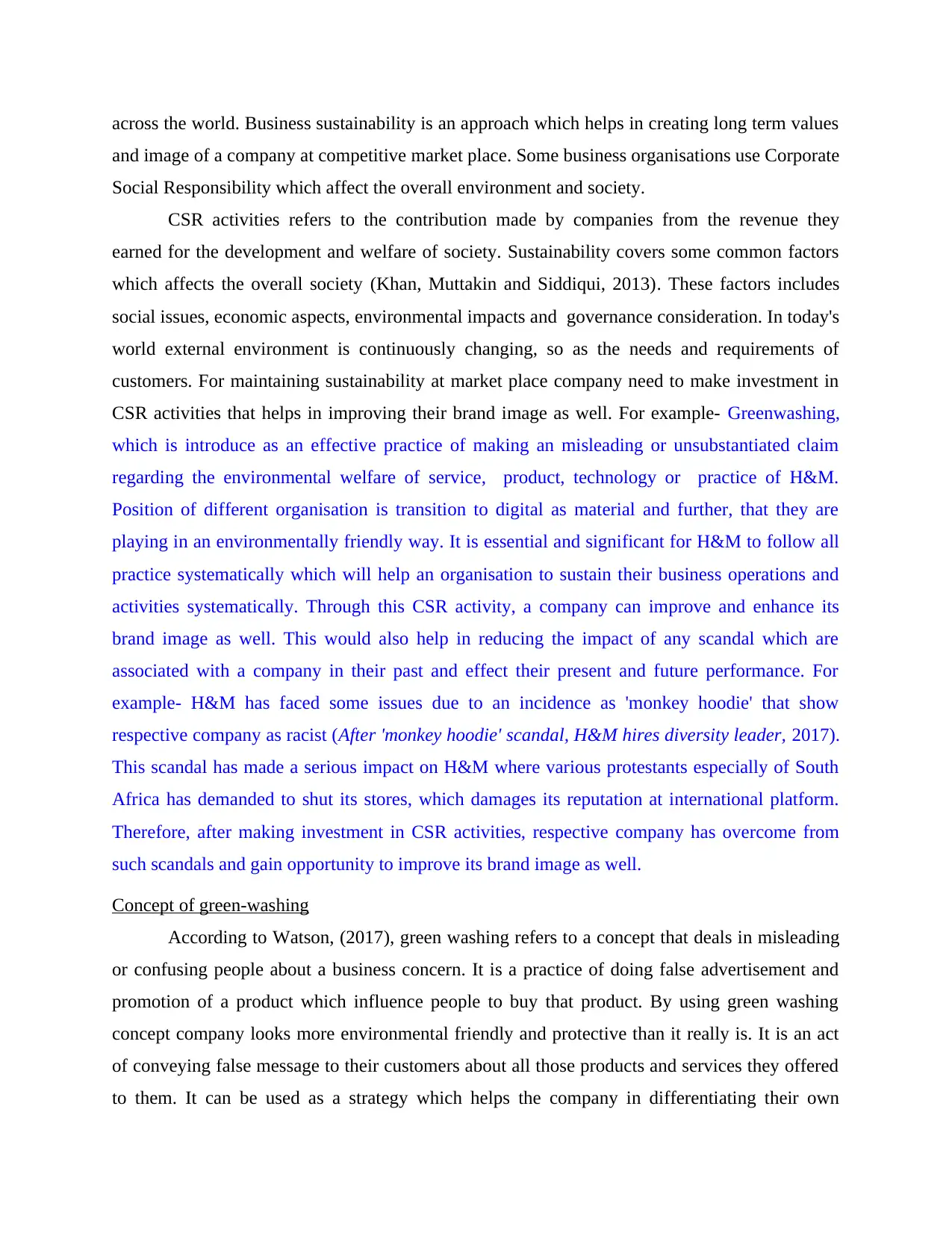
across the world. Business sustainability is an approach which helps in creating long term values
and image of a company at competitive market place. Some business organisations use Corporate
Social Responsibility which affect the overall environment and society.
CSR activities refers to the contribution made by companies from the revenue they
earned for the development and welfare of society. Sustainability covers some common factors
which affects the overall society (Khan, Muttakin and Siddiqui, 2013). These factors includes
social issues, economic aspects, environmental impacts and governance consideration. In today's
world external environment is continuously changing, so as the needs and requirements of
customers. For maintaining sustainability at market place company need to make investment in
CSR activities that helps in improving their brand image as well. For example- Greenwashing,
which is introduce as an effective practice of making an misleading or unsubstantiated claim
regarding the environmental welfare of service, product, technology or practice of H&M.
Position of different organisation is transition to digital as material and further, that they are
playing in an environmentally friendly way. It is essential and significant for H&M to follow all
practice systematically which will help an organisation to sustain their business operations and
activities systematically. Through this CSR activity, a company can improve and enhance its
brand image as well. This would also help in reducing the impact of any scandal which are
associated with a company in their past and effect their present and future performance. For
example- H&M has faced some issues due to an incidence as 'monkey hoodie' that show
respective company as racist (After 'monkey hoodie' scandal, H&M hires diversity leader, 2017).
This scandal has made a serious impact on H&M where various protestants especially of South
Africa has demanded to shut its stores, which damages its reputation at international platform.
Therefore, after making investment in CSR activities, respective company has overcome from
such scandals and gain opportunity to improve its brand image as well.
Concept of green-washing
According to Watson, (2017), green washing refers to a concept that deals in misleading
or confusing people about a business concern. It is a practice of doing false advertisement and
promotion of a product which influence people to buy that product. By using green washing
concept company looks more environmental friendly and protective than it really is. It is an act
of conveying false message to their customers about all those products and services they offered
to them. It can be used as a strategy which helps the company in differentiating their own
and image of a company at competitive market place. Some business organisations use Corporate
Social Responsibility which affect the overall environment and society.
CSR activities refers to the contribution made by companies from the revenue they
earned for the development and welfare of society. Sustainability covers some common factors
which affects the overall society (Khan, Muttakin and Siddiqui, 2013). These factors includes
social issues, economic aspects, environmental impacts and governance consideration. In today's
world external environment is continuously changing, so as the needs and requirements of
customers. For maintaining sustainability at market place company need to make investment in
CSR activities that helps in improving their brand image as well. For example- Greenwashing,
which is introduce as an effective practice of making an misleading or unsubstantiated claim
regarding the environmental welfare of service, product, technology or practice of H&M.
Position of different organisation is transition to digital as material and further, that they are
playing in an environmentally friendly way. It is essential and significant for H&M to follow all
practice systematically which will help an organisation to sustain their business operations and
activities systematically. Through this CSR activity, a company can improve and enhance its
brand image as well. This would also help in reducing the impact of any scandal which are
associated with a company in their past and effect their present and future performance. For
example- H&M has faced some issues due to an incidence as 'monkey hoodie' that show
respective company as racist (After 'monkey hoodie' scandal, H&M hires diversity leader, 2017).
This scandal has made a serious impact on H&M where various protestants especially of South
Africa has demanded to shut its stores, which damages its reputation at international platform.
Therefore, after making investment in CSR activities, respective company has overcome from
such scandals and gain opportunity to improve its brand image as well.
Concept of green-washing
According to Watson, (2017), green washing refers to a concept that deals in misleading
or confusing people about a business concern. It is a practice of doing false advertisement and
promotion of a product which influence people to buy that product. By using green washing
concept company looks more environmental friendly and protective than it really is. It is an act
of conveying false message to their customers about all those products and services they offered
to them. It can be used as a strategy which helps the company in differentiating their own
Paraphrase This Document
Need a fresh take? Get an instant paraphrase of this document with our AI Paraphraser
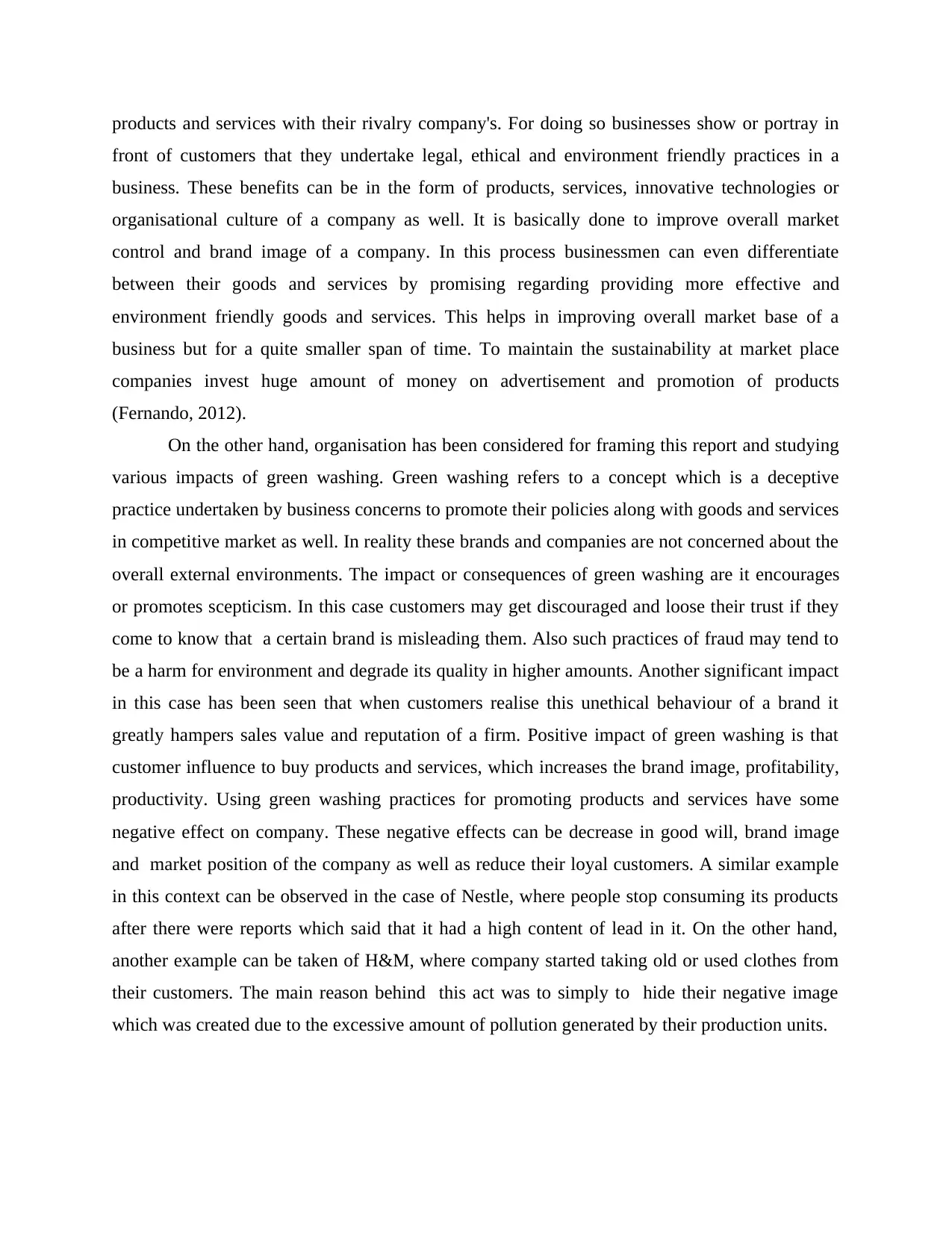
products and services with their rivalry company's. For doing so businesses show or portray in
front of customers that they undertake legal, ethical and environment friendly practices in a
business. These benefits can be in the form of products, services, innovative technologies or
organisational culture of a company as well. It is basically done to improve overall market
control and brand image of a company. In this process businessmen can even differentiate
between their goods and services by promising regarding providing more effective and
environment friendly goods and services. This helps in improving overall market base of a
business but for a quite smaller span of time. To maintain the sustainability at market place
companies invest huge amount of money on advertisement and promotion of products
(Fernando, 2012).
On the other hand, organisation has been considered for framing this report and studying
various impacts of green washing. Green washing refers to a concept which is a deceptive
practice undertaken by business concerns to promote their policies along with goods and services
in competitive market as well. In reality these brands and companies are not concerned about the
overall external environments. The impact or consequences of green washing are it encourages
or promotes scepticism. In this case customers may get discouraged and loose their trust if they
come to know that a certain brand is misleading them. Also such practices of fraud may tend to
be a harm for environment and degrade its quality in higher amounts. Another significant impact
in this case has been seen that when customers realise this unethical behaviour of a brand it
greatly hampers sales value and reputation of a firm. Positive impact of green washing is that
customer influence to buy products and services, which increases the brand image, profitability,
productivity. Using green washing practices for promoting products and services have some
negative effect on company. These negative effects can be decrease in good will, brand image
and market position of the company as well as reduce their loyal customers. A similar example
in this context can be observed in the case of Nestle, where people stop consuming its products
after there were reports which said that it had a high content of lead in it. On the other hand,
another example can be taken of H&M, where company started taking old or used clothes from
their customers. The main reason behind this act was to simply to hide their negative image
which was created due to the excessive amount of pollution generated by their production units.
front of customers that they undertake legal, ethical and environment friendly practices in a
business. These benefits can be in the form of products, services, innovative technologies or
organisational culture of a company as well. It is basically done to improve overall market
control and brand image of a company. In this process businessmen can even differentiate
between their goods and services by promising regarding providing more effective and
environment friendly goods and services. This helps in improving overall market base of a
business but for a quite smaller span of time. To maintain the sustainability at market place
companies invest huge amount of money on advertisement and promotion of products
(Fernando, 2012).
On the other hand, organisation has been considered for framing this report and studying
various impacts of green washing. Green washing refers to a concept which is a deceptive
practice undertaken by business concerns to promote their policies along with goods and services
in competitive market as well. In reality these brands and companies are not concerned about the
overall external environments. The impact or consequences of green washing are it encourages
or promotes scepticism. In this case customers may get discouraged and loose their trust if they
come to know that a certain brand is misleading them. Also such practices of fraud may tend to
be a harm for environment and degrade its quality in higher amounts. Another significant impact
in this case has been seen that when customers realise this unethical behaviour of a brand it
greatly hampers sales value and reputation of a firm. Positive impact of green washing is that
customer influence to buy products and services, which increases the brand image, profitability,
productivity. Using green washing practices for promoting products and services have some
negative effect on company. These negative effects can be decrease in good will, brand image
and market position of the company as well as reduce their loyal customers. A similar example
in this context can be observed in the case of Nestle, where people stop consuming its products
after there were reports which said that it had a high content of lead in it. On the other hand,
another example can be taken of H&M, where company started taking old or used clothes from
their customers. The main reason behind this act was to simply to hide their negative image
which was created due to the excessive amount of pollution generated by their production units.
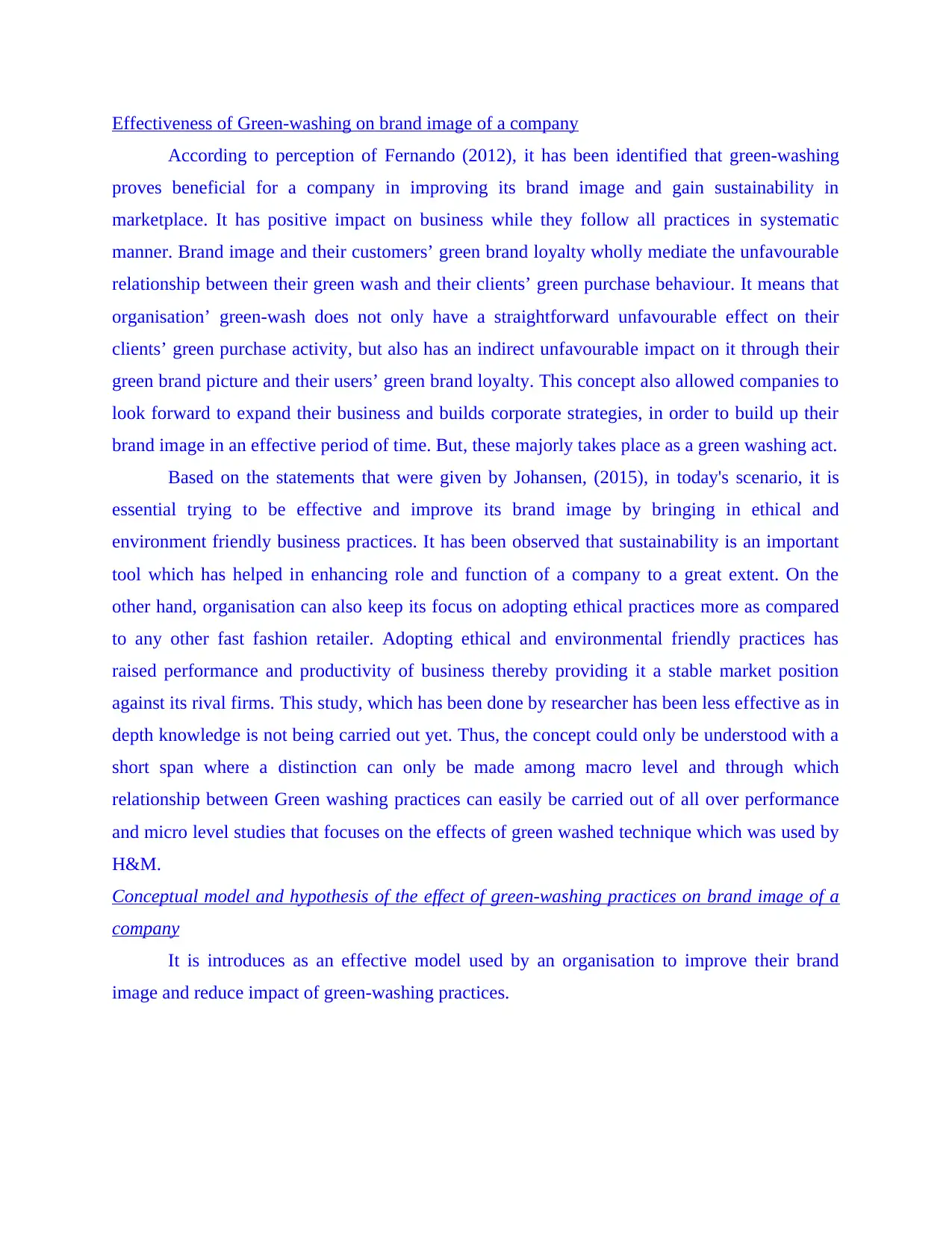
Effectiveness of Green-washing on brand image of a company
According to perception of Fernando (2012), it has been identified that green-washing
proves beneficial for a company in improving its brand image and gain sustainability in
marketplace. It has positive impact on business while they follow all practices in systematic
manner. Brand image and their customers’ green brand loyalty wholly mediate the unfavourable
relationship between their green wash and their clients’ green purchase behaviour. It means that
organisation’ green-wash does not only have a straightforward unfavourable effect on their
clients’ green purchase activity, but also has an indirect unfavourable impact on it through their
green brand picture and their users’ green brand loyalty. This concept also allowed companies to
look forward to expand their business and builds corporate strategies, in order to build up their
brand image in an effective period of time. But, these majorly takes place as a green washing act.
Based on the statements that were given by Johansen, (2015), in today's scenario, it is
essential trying to be effective and improve its brand image by bringing in ethical and
environment friendly business practices. It has been observed that sustainability is an important
tool which has helped in enhancing role and function of a company to a great extent. On the
other hand, organisation can also keep its focus on adopting ethical practices more as compared
to any other fast fashion retailer. Adopting ethical and environmental friendly practices has
raised performance and productivity of business thereby providing it a stable market position
against its rival firms. This study, which has been done by researcher has been less effective as in
depth knowledge is not being carried out yet. Thus, the concept could only be understood with a
short span where a distinction can only be made among macro level and through which
relationship between Green washing practices can easily be carried out of all over performance
and micro level studies that focuses on the effects of green washed technique which was used by
H&M.
Conceptual model and hypothesis of the effect of green-washing practices on brand image of a
company
It is introduces as an effective model used by an organisation to improve their brand
image and reduce impact of green-washing practices.
According to perception of Fernando (2012), it has been identified that green-washing
proves beneficial for a company in improving its brand image and gain sustainability in
marketplace. It has positive impact on business while they follow all practices in systematic
manner. Brand image and their customers’ green brand loyalty wholly mediate the unfavourable
relationship between their green wash and their clients’ green purchase behaviour. It means that
organisation’ green-wash does not only have a straightforward unfavourable effect on their
clients’ green purchase activity, but also has an indirect unfavourable impact on it through their
green brand picture and their users’ green brand loyalty. This concept also allowed companies to
look forward to expand their business and builds corporate strategies, in order to build up their
brand image in an effective period of time. But, these majorly takes place as a green washing act.
Based on the statements that were given by Johansen, (2015), in today's scenario, it is
essential trying to be effective and improve its brand image by bringing in ethical and
environment friendly business practices. It has been observed that sustainability is an important
tool which has helped in enhancing role and function of a company to a great extent. On the
other hand, organisation can also keep its focus on adopting ethical practices more as compared
to any other fast fashion retailer. Adopting ethical and environmental friendly practices has
raised performance and productivity of business thereby providing it a stable market position
against its rival firms. This study, which has been done by researcher has been less effective as in
depth knowledge is not being carried out yet. Thus, the concept could only be understood with a
short span where a distinction can only be made among macro level and through which
relationship between Green washing practices can easily be carried out of all over performance
and micro level studies that focuses on the effects of green washed technique which was used by
H&M.
Conceptual model and hypothesis of the effect of green-washing practices on brand image of a
company
It is introduces as an effective model used by an organisation to improve their brand
image and reduce impact of green-washing practices.
⊘ This is a preview!⊘
Do you want full access?
Subscribe today to unlock all pages.

Trusted by 1+ million students worldwide
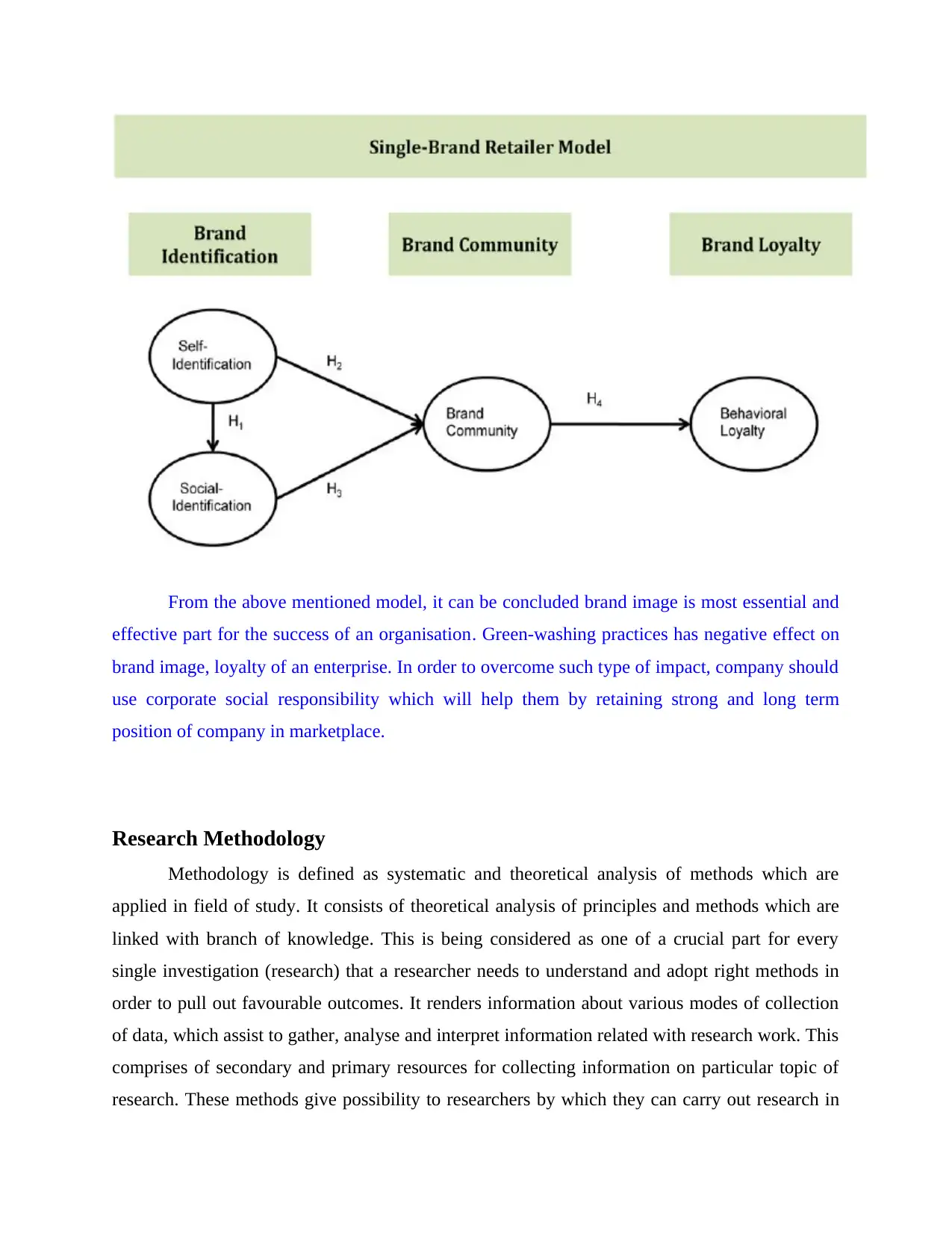
From the above mentioned model, it can be concluded brand image is most essential and
effective part for the success of an organisation. Green-washing practices has negative effect on
brand image, loyalty of an enterprise. In order to overcome such type of impact, company should
use corporate social responsibility which will help them by retaining strong and long term
position of company in marketplace.
Research Methodology
Methodology is defined as systematic and theoretical analysis of methods which are
applied in field of study. It consists of theoretical analysis of principles and methods which are
linked with branch of knowledge. This is being considered as one of a crucial part for every
single investigation (research) that a researcher needs to understand and adopt right methods in
order to pull out favourable outcomes. It renders information about various modes of collection
of data, which assist to gather, analyse and interpret information related with research work. This
comprises of secondary and primary resources for collecting information on particular topic of
research. These methods give possibility to researchers by which they can carry out research in
effective part for the success of an organisation. Green-washing practices has negative effect on
brand image, loyalty of an enterprise. In order to overcome such type of impact, company should
use corporate social responsibility which will help them by retaining strong and long term
position of company in marketplace.
Research Methodology
Methodology is defined as systematic and theoretical analysis of methods which are
applied in field of study. It consists of theoretical analysis of principles and methods which are
linked with branch of knowledge. This is being considered as one of a crucial part for every
single investigation (research) that a researcher needs to understand and adopt right methods in
order to pull out favourable outcomes. It renders information about various modes of collection
of data, which assist to gather, analyse and interpret information related with research work. This
comprises of secondary and primary resources for collecting information on particular topic of
research. These methods give possibility to researchers by which they can carry out research in
Paraphrase This Document
Need a fresh take? Get an instant paraphrase of this document with our AI Paraphraser
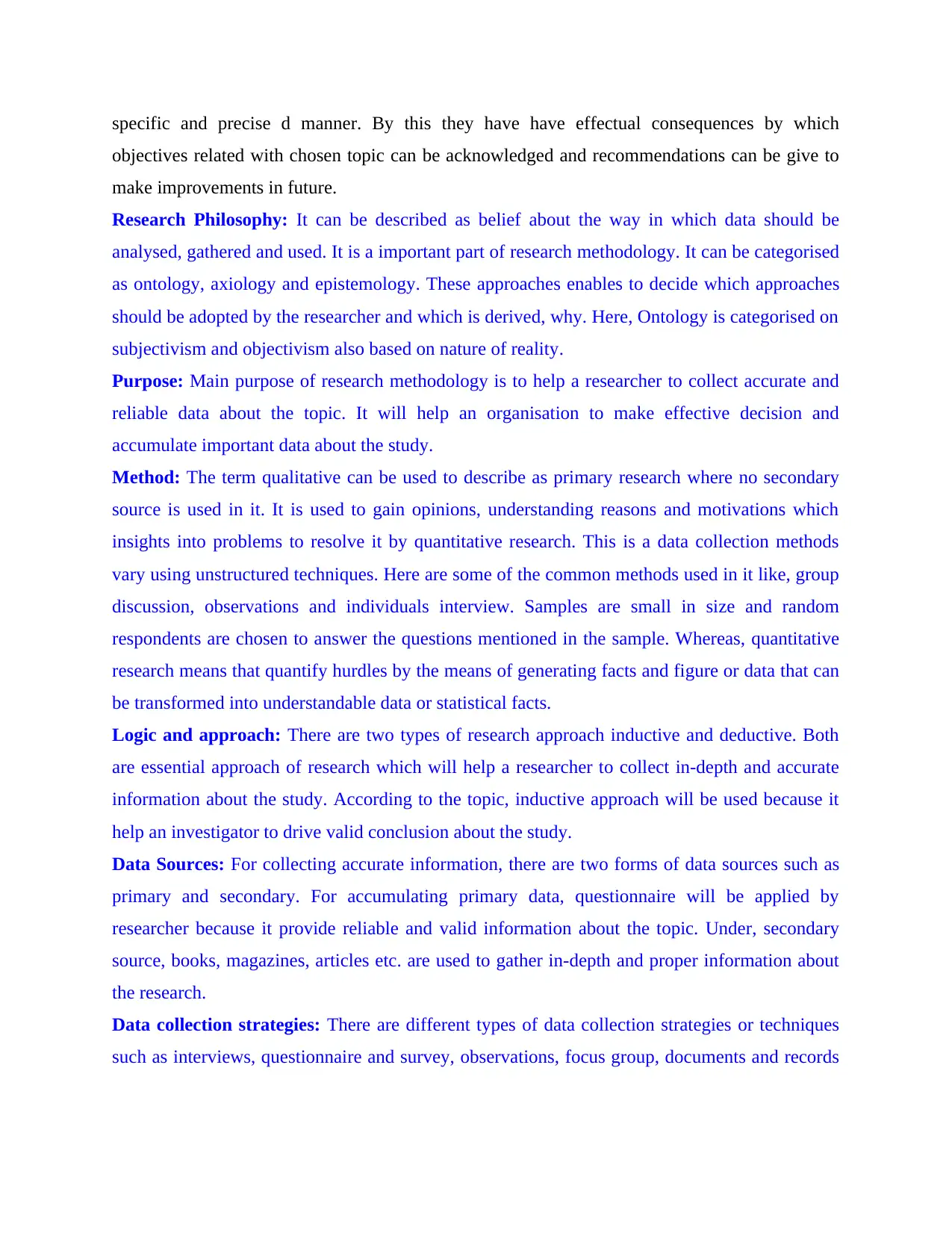
specific and precise d manner. By this they have have effectual consequences by which
objectives related with chosen topic can be acknowledged and recommendations can be give to
make improvements in future.
Research Philosophy: It can be described as belief about the way in which data should be
analysed, gathered and used. It is a important part of research methodology. It can be categorised
as ontology, axiology and epistemology. These approaches enables to decide which approaches
should be adopted by the researcher and which is derived, why. Here, Ontology is categorised on
subjectivism and objectivism also based on nature of reality.
Purpose: Main purpose of research methodology is to help a researcher to collect accurate and
reliable data about the topic. It will help an organisation to make effective decision and
accumulate important data about the study.
Method: The term qualitative can be used to describe as primary research where no secondary
source is used in it. It is used to gain opinions, understanding reasons and motivations which
insights into problems to resolve it by quantitative research. This is a data collection methods
vary using unstructured techniques. Here are some of the common methods used in it like, group
discussion, observations and individuals interview. Samples are small in size and random
respondents are chosen to answer the questions mentioned in the sample. Whereas, quantitative
research means that quantify hurdles by the means of generating facts and figure or data that can
be transformed into understandable data or statistical facts.
Logic and approach: There are two types of research approach inductive and deductive. Both
are essential approach of research which will help a researcher to collect in-depth and accurate
information about the study. According to the topic, inductive approach will be used because it
help an investigator to drive valid conclusion about the study.
Data Sources: For collecting accurate information, there are two forms of data sources such as
primary and secondary. For accumulating primary data, questionnaire will be applied by
researcher because it provide reliable and valid information about the topic. Under, secondary
source, books, magazines, articles etc. are used to gather in-depth and proper information about
the research.
Data collection strategies: There are different types of data collection strategies or techniques
such as interviews, questionnaire and survey, observations, focus group, documents and records
objectives related with chosen topic can be acknowledged and recommendations can be give to
make improvements in future.
Research Philosophy: It can be described as belief about the way in which data should be
analysed, gathered and used. It is a important part of research methodology. It can be categorised
as ontology, axiology and epistemology. These approaches enables to decide which approaches
should be adopted by the researcher and which is derived, why. Here, Ontology is categorised on
subjectivism and objectivism also based on nature of reality.
Purpose: Main purpose of research methodology is to help a researcher to collect accurate and
reliable data about the topic. It will help an organisation to make effective decision and
accumulate important data about the study.
Method: The term qualitative can be used to describe as primary research where no secondary
source is used in it. It is used to gain opinions, understanding reasons and motivations which
insights into problems to resolve it by quantitative research. This is a data collection methods
vary using unstructured techniques. Here are some of the common methods used in it like, group
discussion, observations and individuals interview. Samples are small in size and random
respondents are chosen to answer the questions mentioned in the sample. Whereas, quantitative
research means that quantify hurdles by the means of generating facts and figure or data that can
be transformed into understandable data or statistical facts.
Logic and approach: There are two types of research approach inductive and deductive. Both
are essential approach of research which will help a researcher to collect in-depth and accurate
information about the study. According to the topic, inductive approach will be used because it
help an investigator to drive valid conclusion about the study.
Data Sources: For collecting accurate information, there are two forms of data sources such as
primary and secondary. For accumulating primary data, questionnaire will be applied by
researcher because it provide reliable and valid information about the topic. Under, secondary
source, books, magazines, articles etc. are used to gather in-depth and proper information about
the research.
Data collection strategies: There are different types of data collection strategies or techniques
such as interviews, questionnaire and survey, observations, focus group, documents and records
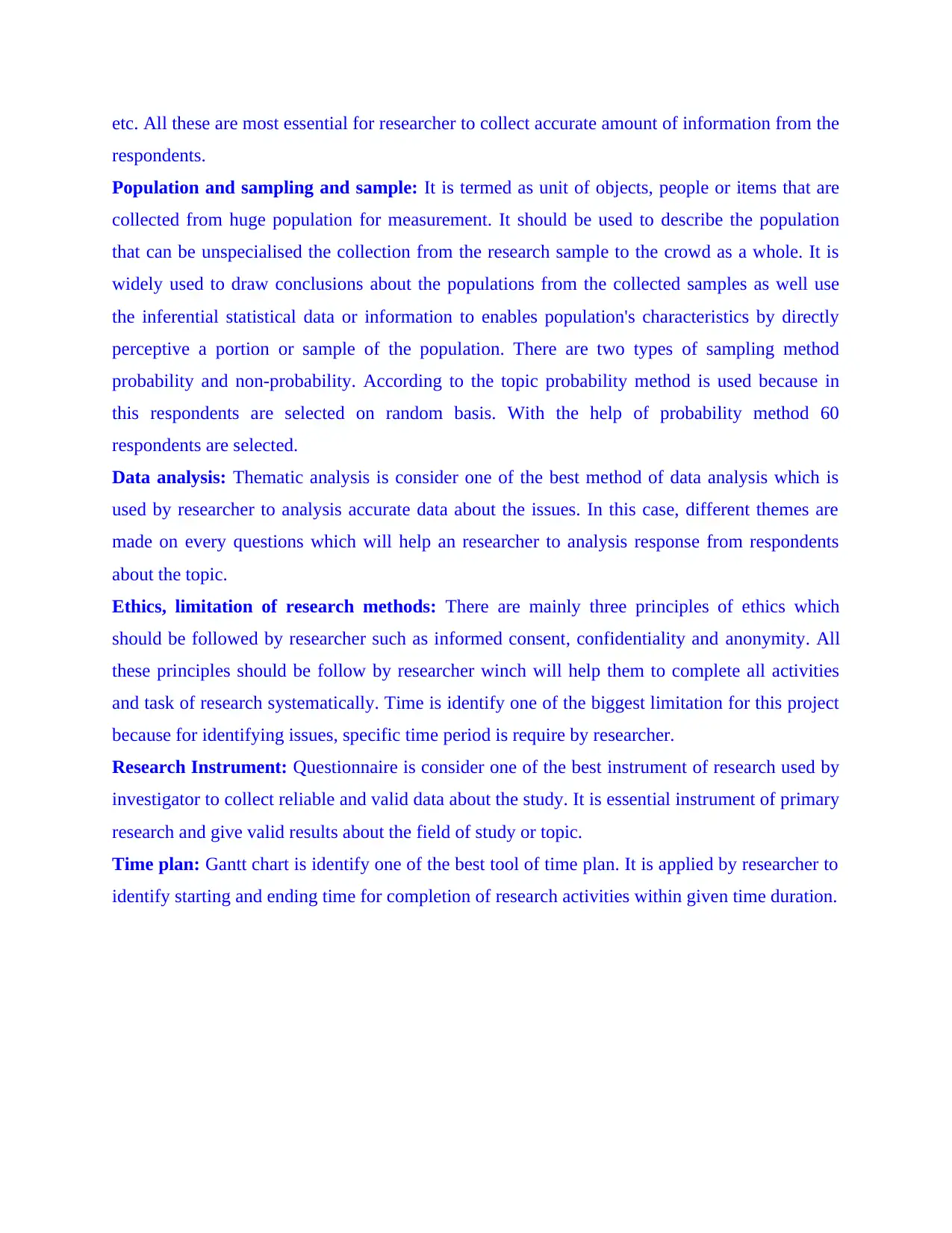
etc. All these are most essential for researcher to collect accurate amount of information from the
respondents.
Population and sampling and sample: It is termed as unit of objects, people or items that are
collected from huge population for measurement. It should be used to describe the population
that can be unspecialised the collection from the research sample to the crowd as a whole. It is
widely used to draw conclusions about the populations from the collected samples as well use
the inferential statistical data or information to enables population's characteristics by directly
perceptive a portion or sample of the population. There are two types of sampling method
probability and non-probability. According to the topic probability method is used because in
this respondents are selected on random basis. With the help of probability method 60
respondents are selected.
Data analysis: Thematic analysis is consider one of the best method of data analysis which is
used by researcher to analysis accurate data about the issues. In this case, different themes are
made on every questions which will help an researcher to analysis response from respondents
about the topic.
Ethics, limitation of research methods: There are mainly three principles of ethics which
should be followed by researcher such as informed consent, confidentiality and anonymity. All
these principles should be follow by researcher winch will help them to complete all activities
and task of research systematically. Time is identify one of the biggest limitation for this project
because for identifying issues, specific time period is require by researcher.
Research Instrument: Questionnaire is consider one of the best instrument of research used by
investigator to collect reliable and valid data about the study. It is essential instrument of primary
research and give valid results about the field of study or topic.
Time plan: Gantt chart is identify one of the best tool of time plan. It is applied by researcher to
identify starting and ending time for completion of research activities within given time duration.
respondents.
Population and sampling and sample: It is termed as unit of objects, people or items that are
collected from huge population for measurement. It should be used to describe the population
that can be unspecialised the collection from the research sample to the crowd as a whole. It is
widely used to draw conclusions about the populations from the collected samples as well use
the inferential statistical data or information to enables population's characteristics by directly
perceptive a portion or sample of the population. There are two types of sampling method
probability and non-probability. According to the topic probability method is used because in
this respondents are selected on random basis. With the help of probability method 60
respondents are selected.
Data analysis: Thematic analysis is consider one of the best method of data analysis which is
used by researcher to analysis accurate data about the issues. In this case, different themes are
made on every questions which will help an researcher to analysis response from respondents
about the topic.
Ethics, limitation of research methods: There are mainly three principles of ethics which
should be followed by researcher such as informed consent, confidentiality and anonymity. All
these principles should be follow by researcher winch will help them to complete all activities
and task of research systematically. Time is identify one of the biggest limitation for this project
because for identifying issues, specific time period is require by researcher.
Research Instrument: Questionnaire is consider one of the best instrument of research used by
investigator to collect reliable and valid data about the study. It is essential instrument of primary
research and give valid results about the field of study or topic.
Time plan: Gantt chart is identify one of the best tool of time plan. It is applied by researcher to
identify starting and ending time for completion of research activities within given time duration.
⊘ This is a preview!⊘
Do you want full access?
Subscribe today to unlock all pages.

Trusted by 1+ million students worldwide
1 out of 31
Related Documents
Your All-in-One AI-Powered Toolkit for Academic Success.
+13062052269
info@desklib.com
Available 24*7 on WhatsApp / Email
![[object Object]](/_next/static/media/star-bottom.7253800d.svg)
Unlock your academic potential
Copyright © 2020–2025 A2Z Services. All Rights Reserved. Developed and managed by ZUCOL.





